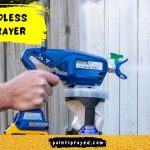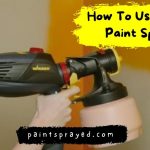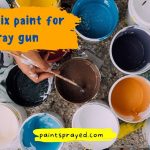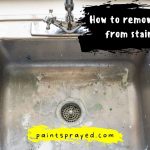In this post today, I will tell you the complete process to spray polyurethane paint without making any mistakes on your desired surface.
Follow this guide in order to achieve the best results and satisfactory finish which you wanted out of your work.
Newbies should follow each step explained in this guide without hesitation and confusion.
Polyurethane spray is a type of synthetic resin. It is different from other coatings that are used to give any surface a protective covering.
It also gives a smooth, hard finish to every surface it is applied. It is widely used as a coating material that covers various surfaces.
How to Spray Polyurethane?
Tools we need to do the job
These tools are required to spray polyurethane paint on your desired surface with the best finish and results which you want. Here is the list of those tools:
- Spray gun or paint sprayer
- Face mask
- Glasses
- Gloves
- Polyurethane paint
- Paint thinner
- 220-grit Sandpaper/low grit
- Drop cloth or rags
- Vacuum cleaner for cleaning purposes
- Mesh filter for filtering paint
- Painters tape or newspaper
Wear protective gear
When spraying polyurethane, UV-resistant rubber gloves should be worn at all times, as should eye goggles and a respirator.
Long-sleeved shirts and long pants are recommended, particularly of a material that is woven or knitted to increase durability.
Prolonged exposure to spray fumes can cause asthma or respiratory problems.
So if you have any doubt about your own health when working with this problematic substance, please visit your doctor first before deciding whether it is suitable for you!
Stir the polyurethane paint
Stir the polyurethane. However, this is not a problem for spray painting; stirring instead adds bubbles to it.
We mix any solids and flattening agents (determine sheen) which have sunk to the bottom by stirring to create a nice coating of non-streaking finish.
That gives off an even coat without streaks in your final paint job.
To stir polyurethane paint properly, there are three main things to keep in mind. First and foremost, you need to be thorough with stirring or the paint won’t have a uniform mixture.
Secondly, you have to use the best technique possible while stirring the paint. There are actually two recommended ways to stir paint.
In the first method, you can use a paint stick, or any other object that would produce stirring action in the bucket.
This is known as the “cut and dip” method. In this method, you simply stir the paint with a paint stick by cutting the surface of the paint with the stick and then dipping the stick back into the paint.
This way, the paint and the air in the mixture are stirred together, creating a more even texture. This is the best way to stir paint.
Process of thinning polyurethane paint
When adding the polyurethane to your paint sprayer you can choose to either thin it down or skip that step.
Adding thinner will make it easier to spray, but it is not necessary. If you choose to thin the finish with water or mineral spirits, follow the instructions on the can when you add your thinner.
Thin polyurethane paint by adding 25% of mineral spirits or another solvent-based thinner to it. You can use lacquer thinner, but mineral spirits and water-based thinners are safer to use.
Select polyurethane paint
When picking spray polyurethane for your project, there are several factors to consider. The kind of spray you choose will affect the drying time and the final result.
Both types of polyurethane can give different results, but they have similar benefits too.
Decide if you want an oil-based or water-based spray so that you can start your project on the right foot with a product that will achieve what it should for less frustration.
Prepare the workplace for spraying polyurethane paint
Spraying polyurethane is tricky, so the finish will probably get onto other wooden surfaces. Use an old sheet to protect other items in your workshop you don’t want to be sprayed.
Also, crack open the windows to ensure proper ventilation. If there is a fan blowing in your direction turn it away or switch it off.
Prepare the surface for painting polyurethane
It’s important to get rid of any excess particles when prepping your wood surface prior to painting.
Dust left over can destroy paint, so we recommend using a tack cloth or vacuum cleaner to remove it.
No matter what type of paint you choose (spray, brush-on, roller), there will still probably be some form of dust on your project.
So, make sure to keep that in mind when you’re working and if anything is blowing outside that may blow some dust onto your surface or floor coverings.
Test the sprayer
When it comes down to spray paint, even motorized sprayers can be a little bit unpredictable.
Just like other motorized tools and machines, you might have to learn how to use the motorized sprayer properly before getting any useful results by doing a first test run on random surfaces.
Once you get a smooth flow with no spluttering, and a relatively even coating over the surface you’re planning on application.
It would be advisable that you test out your own particular item or art piece on one small area of the wooded surface first in order for you to see if there are any modifications.
Or adjustments that need to be made during your second and subsequent sprays so as not to leave unwanted marks on your wooden project’s finish.
Start spraying polyurethane paint
Start spraying the first coat of polyurethane from a distance of about 10-12 inches, so nothing gets left behind on one side of the canister and onto your wood.
This does not need to be explained in great detail. The idea is to explain how it works without being too technical for your target audience.
Don’t use jargon that could turn off potential customers or keep them from buying the product.
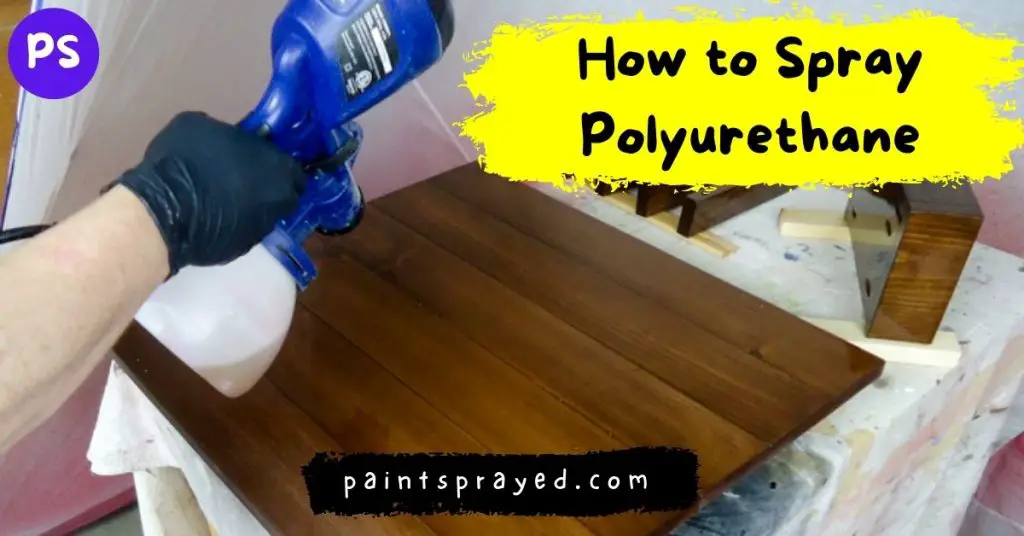
Applying polyurethane takes anywhere from two to four hours to dry completely and be ready for a new coat.
Once it’s dry, use 220-grit sandpaper to eliminate dust nibs, uneven spots or runs. Sand gently, following the grain of the wood.
Don’t go too deep, just enough to make the surface even, and give it a bit of roughness for the next coat to cling to!
Smooth the surface
After sanding, use cloth again to clean the remaining. Be patient while you do this because there will surely be dust particles that haven’t blown back yet – they’re just waiting to be cleaned up.
Apply another coat of polyurethane paint
Apply the second coat in the same manner that you did with your first coat, and make sure to try out the substance first on unfinished wood, thus making sure it is still functioning correctly.
Repeat this process until you have reached the sufficient layer for a satisfying finish.
What most people will usually do is add about 3 or 4 layers onto their surfaces because smoothness generally takes time.
However, if you are watching your budget, feel free to improvise as long as the quality doesn’t suffer too much.
Allow the polyurethane to cure fully before placing heavy items atop its surface because this could cause warping of your work and at times ruin it completely.
This process should take between 3 weeks to 4 weeks depending on whether it is water-based or oil-based polyurethane;
However, keep in mind that drying time does not equate to curing time when working with water-based substances.
So make sure it has dried enough (2 hours) to begin applying another coat if needed.
Tips for spraying polyurethane paint
To ensure a great finish on large pieces of furniture, you’re going to want to apply polyurethane using spray equipment.
Never apply more than one thin coat too quickly, allowing the previous layer to dry first before adding another.
In the case of drips and runs, always cut small sections at a time when applying polyurethane.
Never use this type of product in direct sunlight or with the sun high in the sky; spray instead in full shade on a warm but not hot day.
When fabricating polyurethane, one must keep in mind that applying it is not a get-rich-quick situation.
It can be quite tricky, as this particular substance is not very forgiving – it doesn’t wait for you to make mistakes while you’re putting it on.
Instead, it will hold onto those imperfections and let others know just how badly you messed up the moment you decide to showcase what should have been a beautiful work of art.
Therefore, please do us both a favor and DO NOT spray runny wet coats of poly on surfaces.
Spray Polyurethane Vs. Brush On
Almost any homemade paint job is going to have brush strokes.
That’s why it takes a lot of good scrubbing, feather-light taping, and a second coat to achieve the look you want. But with a little helpful advice from a mentor.
You can use this paint project as the perfect opportunity to practice just the right motions for making your own crafty decor items.
Like picture frames and plates that look good enough for framing!
Here are some helpful hints so you can make smooth surfaces without destroying your home.
Does polyurethane need to be thinned to spray?
Polyurethane is a thick, viscous material that needs to be thinned in order to be sprayed through a paint sprayer.
The amount of thinning required will depend on the specific type of polyurethane and the type of sprayer being used.
When thinning polyurethane for spraying, it is important to use the appropriate thinner or reducer.
The type of thinner or reducer used will depend on the type of polyurethane and the desired final consistency.
For example, some polyurethane products require the use of a specific type of reducer or thinner, while others may be thinned with mineral spirits or lacquer thinner.
It’s always best to check the manufacturer’s instructions for the specific polyurethane product you are using.
As well as the sprayer you will be using, as they will provide the recommended thinning ratios.
In general, a good starting point is to mix the polyurethane with a thinner or reducer at a ratio of about 20-25% thinner to 75-80% polyurethane.
This will give you a consistency that will flow through the sprayer easily.
It’s worth noting that thinning polyurethane will affect its final properties, such as its curing time.
Gloss, and durability, so it’s important to use the recommended thinner or reducer and thinning ratio.
Can polyurethane be applied with a sprayer?
Yes, polyurethane can be applied with a sprayer. It is important to use the correct type of sprayer and to properly prepare the surface to be coated.
Additionally, the polyurethane should be thinned to the appropriate consistency for the sprayer being used.
It is also highly recommended to use a respirator or mask and protective clothing as the fumes of polyurethane can be harmful to inhale.
Is it better to spray or brush polyurethane?
Both spraying and brushing polyurethane can result in a good finish, but they have different advantages and disadvantages.
Spraying polyurethane can result in a smoother and more even finish than brushing, as it eliminates brush marks.
However, it can be more difficult to achieve a consistent finish with spraying, and it requires specialized equipment and more experience to use properly.
Additionally, it can be messy and requires more prep work for the surrounding area.
Brushing polyurethane can be more forgiving, as it is easier to control the amount of finish being applied and to work it into tight spaces.
However, it can be more time consuming and result in brush marks.
So, whether to spray or brush polyurethane depends on your specific situation, including the type of surface you’re finishing.
The size of the area you’re working on, and your own skills and experience.
What type of spray gun is best for polyurethane?
The type of spray gun that is best for polyurethane depends on the specific application and the viscosity of the polyurethane.
For thicker viscosity polyurethane, an airless spray gun is a good option. These types of spray guns use high pressure to atomize the finish, which allows for a smooth and even application.
For thinner viscosity polyurethane, a HVLP (high volume, low pressure) spray gun would be a better option.
HVLP spray guns use a lower pressure than airless spray guns, which results in less overspray and more control over the application of the finish.
It’s important to match the spray gun tip size to the viscosity of the polyurethane, and the tip size needed can vary depending on the manufacturer of the polyurethane.
Also it’s recommended to use a respirator or mask and protective clothing as the fumes of polyurethane can be harmful to inhale.
What’s the best way to spray polyurethane?
Spraying polyurethane is a great way to achieve a smooth and professional finish on your woodworking projects. However, it can be a bit tricky if you’ve never done it before. In this guide, I’ll walk you through the best way to spray polyurethane.
Here are the steps you should follow:
Step 1: Prepare your work area
Before you start spraying, make sure your work area is clean and well-ventilated. You’ll want to set up a space where you can spray without getting overspray on anything you don’t want to coat. Cover the floor and any nearby surfaces with plastic sheeting or drop cloths. You may also want to wear a dust mask to protect your lungs from the polyurethane fumes.
Step 2: Choose the right equipment
You’ll need a few pieces of equipment to spray polyurethane. Here’s what you’ll need:
- A high-volume, low-pressure (HVLP) sprayer: This type of sprayer is ideal for polyurethane because it produces a fine mist that coats surfaces evenly. HVLP sprayers are also more efficient and waste less material than other types of sprayers.
- A compressor: You’ll need an air compressor to power your HVLP sprayer.
- A spray gun: Your HVLP sprayer should come with a spray gun. Make sure it’s clean and in good condition before you start spraying.
- Polyurethane: Choose a high-quality polyurethane that’s designed for spraying. Read the label carefully to make sure it’s compatible with your sprayer.
Step 3: Practice on scrap wood
Before you start spraying your project, it’s a good idea to practice on a piece of scrap wood. This will help you get a feel for the sprayer and adjust the spray pattern and flow rate as needed.
Step 4: Spray the polyurethane
Once you’re comfortable with the sprayer, you can start spraying the polyurethane on your project. Here’s how to do it:
- Hold the spray gun about 6-8 inches away from the surface you’re spraying.
- Start spraying off to the side of your project and move the gun in a steady back-and-forth motion.
- Overlap each pass by about 50% to ensure even coverage.
- Keep the gun moving at a consistent speed to avoid drips and runs.
- Spray in light coats to avoid buildup and drips. You can always add more coats later if needed.
- Let each coat dry completely before applying the next coat.
Step 5: Sand between coats
After each coat dries, use a fine-grit sandpaper (220-grit or higher) to lightly sand the surface. This will help smooth out any imperfections and provide a better surface for the next coat to adhere to.
Step 6: Apply multiple coats
Repeat steps 4 and 5 until you’ve achieved the desired level of finish. Most projects will require 2-3 coats of polyurethane.
How do you spray polyurethane with a spray gun?
Spraying polyurethane with a spray gun is a great way to achieve a smooth and even finish on your woodworking projects. Here’s a step-by-step guide on how to do it:
Step 1: Prepare your work area
Before you start spraying, make sure your work area is clean and well-ventilated. You’ll want to set up a space where you can spray without getting overspray on anything you don’t want to coat.
Cover the floor and any nearby surfaces with plastic sheeting or drop cloths. You may also want to wear a dust mask to protect your lungs from the polyurethane fumes.
Step 2: Choose the right equipment
You’ll need a few pieces of equipment to spray polyurethane with a spray gun. Here’s what you’ll need:
- A spray gun: Choose a high-quality spray gun that’s designed for polyurethane. Make sure it’s clean and in good condition before you start spraying.
- A compressor: You’ll need an air compressor to power your spray gun.
- Polyurethane: Choose a high-quality polyurethane that’s designed for spraying. Read the label carefully to make sure it’s compatible with your spray gun.
Step 3: Mix the polyurethane
Polyurethane needs to be mixed thoroughly before spraying. Follow the manufacturer’s instructions carefully to ensure that you get the right mix. Some polyurethane products require thinning with a solvent before spraying, so make sure to read the label.
Step 4: Adjust the spray gun
Before you start spraying, adjust the spray gun to the right settings. You’ll need to adjust the air pressure and the fluid flow to get the right spray pattern.
Start with a low air pressure and fluid flow, and gradually increase it until you get the right pattern.
Step 5: Practice on scrap wood
Before you start spraying your project, it’s a good idea to practice on a piece of scrap wood. This will help you get a feel for the spray gun and adjust the spray pattern and flow rate as needed.
Step 6: Spray the polyurethane
Once you’re comfortable with the spray gun, you can start spraying the polyurethane on your project. Here’s how to do it:
- Hold the spray gun about 6-8 inches away from the surface you’re spraying.
- Start spraying off to the side of your project and move the gun in a steady back-and-forth motion.
- Overlap each pass by about 50% to ensure even coverage.
- Keep the gun moving at a consistent speed to avoid drips and runs.
- Spray in light coats to avoid buildup and drips. You can always add more coats later if needed.
- Let each coat dry completely before applying the next coat.
Step 7: Sand between coats
After each coat dries, use a fine-grit sandpaper (220-grit or higher) to lightly sand the surface. This will help smooth out any imperfections and provide a better surface for the next coat to adhere to.
Step 8: Apply multiple coats
Repeat steps 6 and 7 until you’ve achieved the desired level of finish. Most projects will require 2-3 coats of polyurethane.
Choose the Best Personal Protective Equipment for Spraying Polyurethane
If you’re planning to spray polyurethane, you’ll need personal protective equipment (PPE) to ensure your safety.
Polyurethane spray contains harmful chemicals that can cause skin and eye irritation, respiratory problems, and even cancer.
Choosing the right PPE is crucial to protect yourself from these hazards. Here are some recommendations on the best PPE to use when spraying polyurethane.
- Respirator
A respirator is a crucial piece of PPE when spraying polyurethane. It protects your lungs from breathing in harmful fumes and particles that may cause respiratory problems.
Choose a respirator with an N95 rating or higher, as it can filter out up to 95% of airborne particles. Make sure it fits snugly to your face and has an appropriate filter cartridge for polyurethane spray.
- Gloves
Wearing gloves can protect your skin from coming into contact with polyurethane spray, which can cause skin irritation and allergic reactions.
Nitrile gloves are the best choice for handling polyurethane spray, as they are resistant to chemicals and punctures.
- Coveralls
Coveralls provide full-body protection from polyurethane spray. They can prevent skin contact and prevent the spray from seeping through clothing onto the skin.
Choose coveralls made of a material that is resistant to chemicals and punctures, such as Tyvek.
- Safety Glasses or Goggles
Polyurethane spray can cause eye irritation, and it is essential to protect your eyes from contact. Safety glasses or goggles with side shields can provide adequate protection. Choose ones that fit well and have clear lenses to allow good visibility.
- Head Covering
Protect your hair and scalp by wearing a head covering. A disposable hood made of Tyvek can provide good protection and prevent hair from becoming contaminated with polyurethane spray.
10 Essential Safety Precautions for Spraying Polyurethane
Spraying polyurethane can be a great way to get a smooth, professional finish on your woodworking projects.
However, it’s important to take the necessary safety precautions to avoid any potential hazards. Here are 10 essential safety precautions to keep in mind when spraying polyurethane:
- Wear Protective Gear: Before you start spraying, make sure you have the appropriate personal protective equipment (PPE) on hand. This includes safety glasses or goggles, a respirator or face mask, and gloves to protect your skin.
- Work in a Well-Ventilated Area: Polyurethane spray can release fumes that are harmful to inhale. Work in a well-ventilated area with plenty of fresh air flow, such as an outdoor space or a well-ventilated workshop.
- Keep the Area Clean and Organized: Keep your work area clean and organized to minimize the risk of accidents or spills. Make sure to remove any combustible materials from the area.
- Don’t Smoke: Smoking while spraying polyurethane is extremely dangerous and can cause fires or explosions. Make sure to keep any open flames or smoking materials away from your work area.
- Use Proper Equipment: Use equipment that is designed for spraying polyurethane, including an appropriate spray gun and air compressor. Make sure to follow the manufacturer’s instructions for proper use.
- Test the Spray: Before spraying your entire project, do a test spray on a small piece of scrap wood to make sure the finish is even and consistent.
- Protect Your Eyes: Wear protective eyewear to prevent any particles from getting into your eyes while spraying. A full face mask can also provide protection from fumes.
- Avoid Skin Contact: Polyurethane can irritate the skin and cause chemical burns. Wear gloves and long sleeves to avoid skin contact. If you do come into contact with polyurethane, wash the affected area immediately with soap and water.
- Take Breaks: Spraying polyurethane can be tiring work. Take regular breaks to avoid fatigue and stay alert.
- Proper Disposal: Properly dispose of any leftover polyurethane and cleaning materials in accordance with local regulations. Do not pour polyurethane down the drain or throw it in the trash.
By following these essential safety precautions, you can ensure a safe and successful polyurethane spraying experience.
How to Choose the Right Spray Gun for Polyurethane?
Choosing the right spray gun for polyurethane is an important decision that can impact the quality and finish of your woodworking projects.
Here are some key factors to consider when choosing a spray gun for polyurethane:
- Size and Type of Project: Consider the size and type of project you’ll be working on. For smaller projects, a gravity-feed spray gun may be more appropriate, while larger projects may require a pressure-feed or HVLP spray gun.
- Viscosity of the Polyurethane: The viscosity of the polyurethane you’re using will also play a role in determining the appropriate spray gun. Thicker polyurethane will require a spray gun with a larger tip size and higher fluid pressure.
- Spray Pattern: The spray pattern of the gun will determine the width and shape of the spray pattern. Consider the size and shape of the project you’re working on to determine the appropriate spray pattern.
- Air Compressor: The air compressor you’re using will also affect the performance of your spray gun. Make sure the air compressor is capable of providing the necessary pressure and volume of air for your spray gun.
- Brand and Quality: Choose a reputable brand and high-quality spray gun to ensure consistent and reliable performance.
- Ease of Use and Maintenance: Look for a spray gun that is easy to use and maintain. Consider the ease of cleaning and replacing parts, as well as the availability of replacement parts.
- Cost: Finally, consider the cost of the spray gun. While high-end spray guns may offer better performance and durability, they may not be necessary for every project. Determine your budget and choose a spray gun that meets your needs without breaking the bank.
Building a DIY Spray Booth for Polyurethane Spraying
Building a DIY spray booth for polyurethane spraying can be a great way to ensure a safe and controlled environment for your woodworking projects.
Here are some steps to help you build your own spray booth:
- Choose a Location: First, choose a location for your spray booth. This could be a garage or workshop with adequate space, ventilation, and access to electricity.
- Determine the Size: Next, determine the size of the spray booth based on the size of the projects you’ll be spraying. Consider the height, width, and depth of the booth to ensure adequate space for the projects.
- Frame the Structure: Use PVC pipes or lumber to frame the structure of the spray booth. Make sure to securely anchor the frame to the floor or walls for stability.
- Cover the Structure: Cover the frame with plastic sheeting or tarpaulin to create the walls and ceiling of the spray booth. Use a staple gun or strong adhesive tape to attach the sheeting to the frame.
- Install Ventilation: Install a ventilation system to remove fumes from the spray booth. This can be achieved by installing an exhaust fan and ductwork to vent the fumes outside or using a filtration system to purify the air inside the booth.
- Add Lighting: Add lighting to the spray booth to ensure adequate visibility during spraying. Install bright, non-explosive lights that are safe for use around solvents.
- Create a Work Surface: Create a work surface inside the spray booth using a sawhorse, workbench, or similar structure. Make sure the work surface is stable and level.
- Test the Spray Booth: Once the spray booth is complete, test it to ensure it’s functioning properly. Use a small amount of polyurethane on a scrap piece of wood to ensure the ventilation system is working effectively and that there are no leaks in the structure.
Building a DIY spray booth for polyurethane spraying can be a cost-effective and safe solution for your woodworking projects.
By following these steps, you can build a spray booth that meets your needs and helps you achieve the best possible results.
Understanding the Different Types of Polyurethane
Polyurethane is a versatile material commonly used in woodworking and construction projects.
There are different types of polyurethane available, each with unique properties and applications. Here are some of the most common types of polyurethane and their characteristics:
- Oil-based Polyurethane: Oil-based polyurethane is a popular choice for woodworking projects due to its durability and water resistance. It is easy to apply and dries to a clear, glossy finish.
- Water-based Polyurethane: Water-based polyurethane is an environmentally friendly alternative to oil-based polyurethane. It dries faster and emits fewer fumes, making it easier to work with. It is also available in different finishes, including matte and glossy.
- Moisture-cured Polyurethane: Moisture-cured polyurethane is a durable and water-resistant option for outdoor projects. It cures by reacting with moisture in the air, making it a good choice for humid environments.
- Polyurethane Foam: Polyurethane foam is a lightweight and insulating material commonly used in construction and insulation projects. It can be sprayed or injected into walls, roofs, and other structures to provide insulation and fill gaps.
- Thermoplastic Polyurethane: Thermoplastic polyurethane is a flexible and durable material commonly used in the manufacturing of sports equipment, shoes, and other products. It is resistant to abrasions, tears, and weather damage.
- Rigid Polyurethane: Rigid polyurethane is a lightweight and strong material used in the manufacturing of insulation panels, packaging, and other products. It provides excellent insulation properties and can be molded into various shapes and sizes.
Understanding the different types of polyurethane can help you choose the right material for your woodworking or construction project.
Consider the application, durability, and environmental impact of each type to determine the best fit for your needs.
How to Troubleshoot Common Issues with Polyurethane Spraying?
Polyurethane spraying is a popular technique for achieving a smooth and even finish on woodworking projects.
However, like any technique, it can encounter some common issues that can affect the final outcome. Here are some troubleshooting tips for common issues with polyurethane spraying:
- Uneven Finish: If your finish appears uneven, it may be due to improper spraying technique or insufficient sanding between coats. Try applying the polyurethane in light, even coats, and sanding between each coat to ensure a smooth finish.
- Orange Peel Texture: Orange peel texture refers to a bumpy or rough texture on the surface of the finish. This can be caused by spraying too far away from the surface or using a spray gun with too high a pressure. Adjust the distance of the spray gun from the surface and reduce the pressure to achieve a smooth finish.
- Drips or Runs: Drips or runs occur when too much polyurethane is applied in one area. To fix this, wait for the polyurethane to dry completely and then sand away the drip or run using fine-grit sandpaper. Reapply a light coat of polyurethane to the sanded area.
- Bubbling: Bubbling can occur when the polyurethane is applied over a surface that is not completely dry or has moisture trapped underneath. Ensure the surface is clean and dry before applying the polyurethane, and avoid applying it in humid or damp conditions.
- Fisheye or Cratering: Fisheye or cratering refers to small, circular marks on the surface of the finish. This can be caused by contaminants on the surface, such as dust or grease. Ensure the surface is clean and free of any contaminants before applying the polyurethane.
- Cloudy Finish: A cloudy finish can occur when the polyurethane is applied in humid or cold conditions. Wait for a dry and warm day to apply the polyurethane to avoid this issue.
How to Sand and Buff Polyurethane for a Perfect Finish?
Sanding and buffing polyurethane is an essential step in achieving a smooth and polished finish on woodworking projects. Here are the steps to sand and buff polyurethane for a perfect finish:
- Sanding: Sanding helps to remove any imperfections on the surface of the polyurethane and creates a smooth and even finish. Begin by sanding with a coarse grit sandpaper, such as 220-grit, and gradually work your way up to a finer grit, such as 400 or 600-grit. Sand in a circular motion to avoid leaving visible scratches on the surface.
- Cleaning: Once you have finished sanding, use a tack cloth or a microfiber cloth to remove any dust and debris from the surface. Ensure the surface is clean and free of any contaminants before moving on to buffing.
- Buffing: Buffing helps to bring out the shine and polish on the surface of the polyurethane. Begin by applying a small amount of polishing compound to a buffing pad or a soft cloth. Buff the surface in a circular motion, applying light pressure. Gradually increase the pressure to achieve a high shine.
- Finishing: Once you have finished buffing, wipe the surface with a clean, dry cloth to remove any excess polishing compound. You can apply a final coat of polyurethane to protect the surface and enhance its shine.
It is important to take your time when sanding and buffing polyurethane to ensure a perfect finish. Be patient and work slowly, using a light touch to avoid damaging the surface.
With the right technique and tools, you can achieve a smooth, polished finish on your woodworking projects.
Proper Maintenance for Your Polyurethane Spraying Equipment
Polyurethane spraying equipment is an investment that requires proper maintenance to ensure it functions efficiently and lasts for a long time.
Here are some tips for maintaining your polyurethane spraying equipment:
- Clean the Equipment: After each use, clean the equipment thoroughly with warm water and soap to remove any residual polyurethane. Use a soft-bristled brush to clean hard-to-reach areas. Rinse the equipment with clean water and allow it to dry completely.
- Lubricate the Equipment: Regularly lubricate the moving parts of the equipment with a high-quality lubricant to prevent rust and corrosion. Apply a small amount of lubricant to a soft cloth and apply it to the moving parts.
- Replace Worn Parts: Check your equipment regularly for signs of wear and tear, such as cracks or breaks. Replace any worn or damaged parts to ensure the equipment functions properly.
- Store the Equipment Properly: Store the equipment in a clean, dry, and well-ventilated area to prevent moisture and dust from accumulating. Keep the equipment covered with a dust cover or plastic sheet to protect it from the elements.
- Use the Equipment Correctly: Follow the manufacturer’s instructions when using the equipment, including the recommended pressure settings and cleaning procedures. Avoid using the equipment for purposes other than spraying polyurethane.
FAQ’s of How to Spray Polyurethane
Conclusion of How to Spray Polyurethane
I hope you enjoyed reading our blog post on How to spray polyurethane. If you are looking for more tips, we highly recommend reading our other blog posts daily.
I hope I have been able to clear up any questions you may have had on how to spray polyurethane.
And now, you are able to use polyurethane with ease! If you have any other questions, please feel free to contact us in the comments section.

Matthew Edward is a professional painter who loves to paint and wants to share useful tips and tricks which he had learned in many years of experience in painting. He also used many products that can be used for painting he has tried and tested each and every product to give an unbias opinion about it in his review. This blog is very useful for those newbies who want to learn painting without making mistakes.

